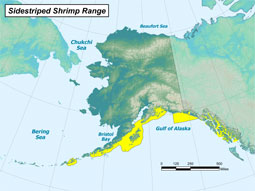Sidestriped Shrimp
(Pandalopsis dispar)
Printer Friendly

Did You Know?
Most sidestriped shrimp begin their lives as males and become female after a year or two.
General Description
Sidestriped shrimp are slender, pinkish-orange in color, with white stripes running lengthwise on the body. They can reach about 208 mm (8 inches) in length. Sidestriped shrimp also have extremely long antennae (1.5 times body length) compared to other Alaska shrimp species.
Life History
Growth and Reproduction
Sidestriped shrimp are members of the Pandalid shrimp family. Most Pandalid shrimp mature to be male. They usually mate one or two seasons as male, but later transform into female. Sidestriped shrimp reproduce in the fall, though this may vary. Eggs hatch in the spring. The larva are very small and free-swimming, but are at the mercy of ocean currents. They feed on plankton, grow rapidly and molt frequently. Finally, the shrimp has its last larval molt and looks like an adult shrimp only small. These juvenile shrimp sink to the bottom.
The mature female sidestriped shrimp molts into a special shell, built for carrying eggs. A male shrimp grasps the female and deposits a sperm packet on the underside of the female. The female extrudes eggs, which are fertilized as they pass over the sperm packet. Tiny hair-like structures on the female’s abdomen (setae) hold the eggs in place until hatching in the spring.
Feeding Ecology
Larval shrimp feed on plankton. Juvenile and adult shrimp are opportunistic in their feeding habits. They will eat worms, diatoms, algae, smaller invertebrates, and dead organic matter.
Fish (such as cod, pollock, and salmon) and humans are the main predators of sidestriped shrimp.
Movement
Shrimp migrate seasonally, but most of their movement is vertical, within the water column, on a daily basis in order to feed.
Range and Habitat
Sidestriped shrimp live in the northeastern Pacific Ocean, ranging from the Bering Sea to northern Oregon.
Sidestriped shrimp are ocean bottom dwellers, living from 45 to 640 meters (150 to 2100 feet) deep. They prefer soft muddy bottoms.
Status, Trends, and Threats
Status
The status of sidestriped shrimp populations is unknown.
Trends
Commercial shrimp harvest in Alaska peaked in 1976 at 129 million pounds that season. Annual trawl harvests are now far below historical levels; indicating a downward trend in shrimp populations.
Threats
Potential threats would be loss of habitat, offshore oil spills, global warming.
Fast Facts
-
Size
Up to 208 mm (8 inches) in length -
Range/Distribution
Coastal waters from the Bering Sea to northern Oregon -
Diet
Detritus, algae, invertebrates, worms, diatoms -
Predators
Fish and humans -
Reproduction
Eggs fertilized externally and remain with the female until hatching. -
Remarks
Mainly harvested by commercial trawlers; occasionally captured in shrimp pots
Did You Know?
- Most sidestriped shrimp begin their lives as males and become female after a year or two.
- The sidestriped shrimp female can carry between 200 and 4,000 eggs.
- Most sidestriped shrimp are caught by trawlers, not pots.
Uses
Sidestriped shrimp are harvested as food for human consumption. Sidestriped shrimp are mainly caught by commercial trawlers. A small portion of sidestriped shrimp are caught in the pots of subsistence, sport, and personal use shrimpers.
Get Involved
The best way to be involved with the management of sidestriped shrimp is to attend local advisory council meetings and Alaska Board of Fish meetings. If you have concerns about sidestriped shrimp you may put in a proposal to the Board of Fish with ideas as to how to address those concerns.

